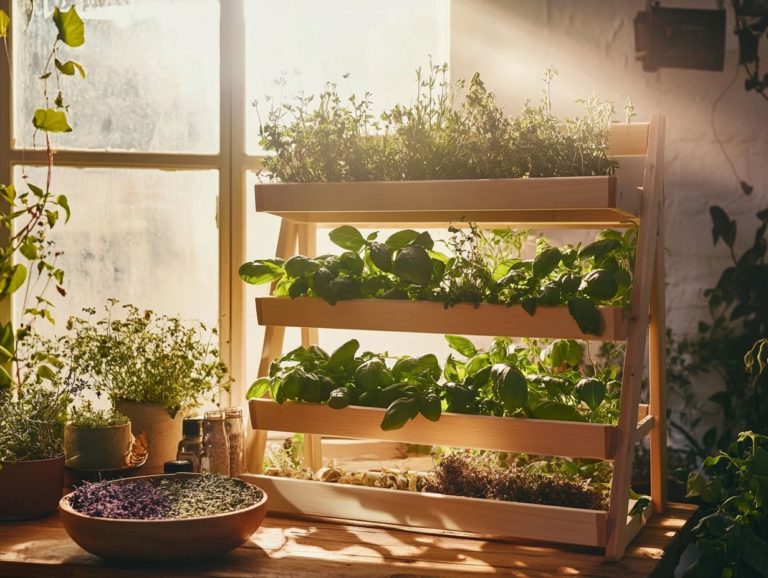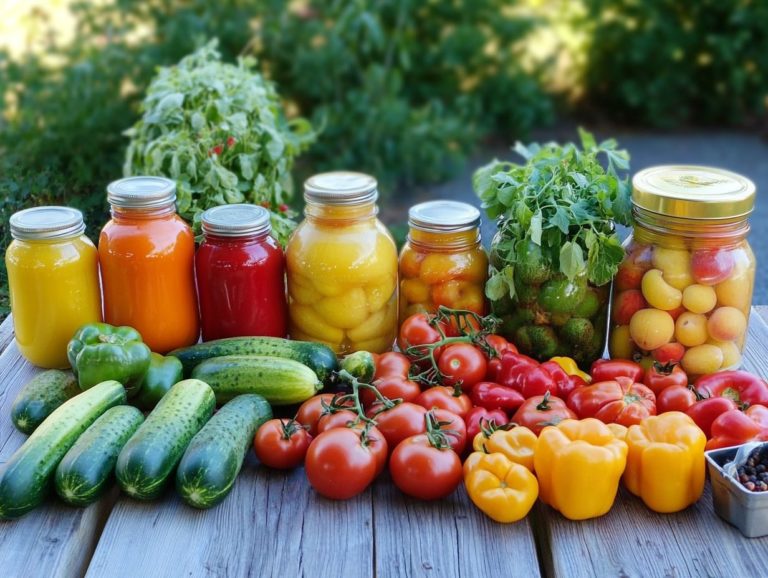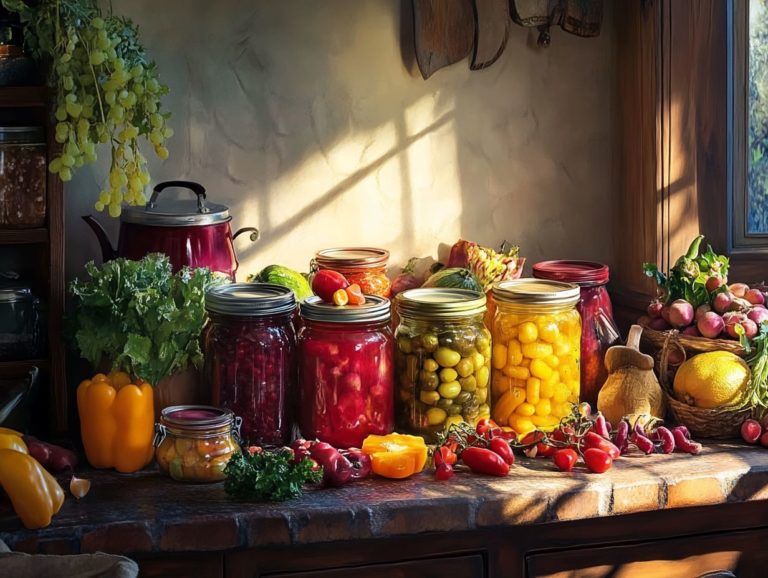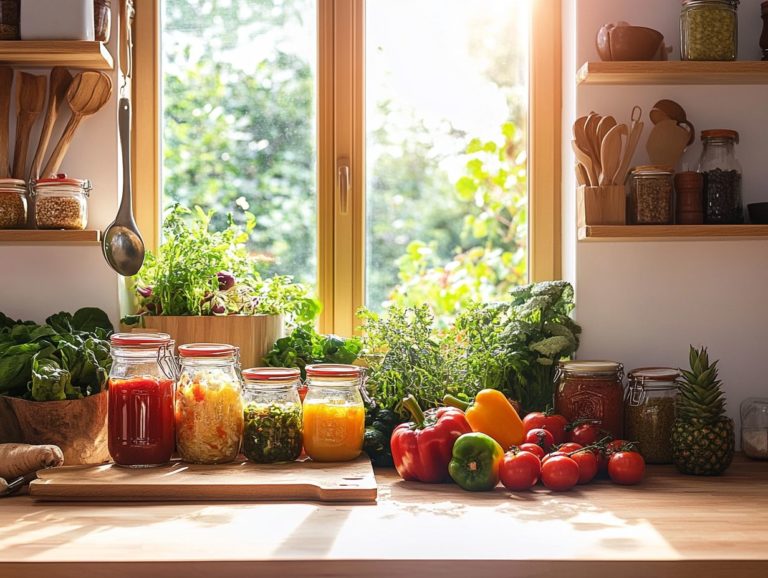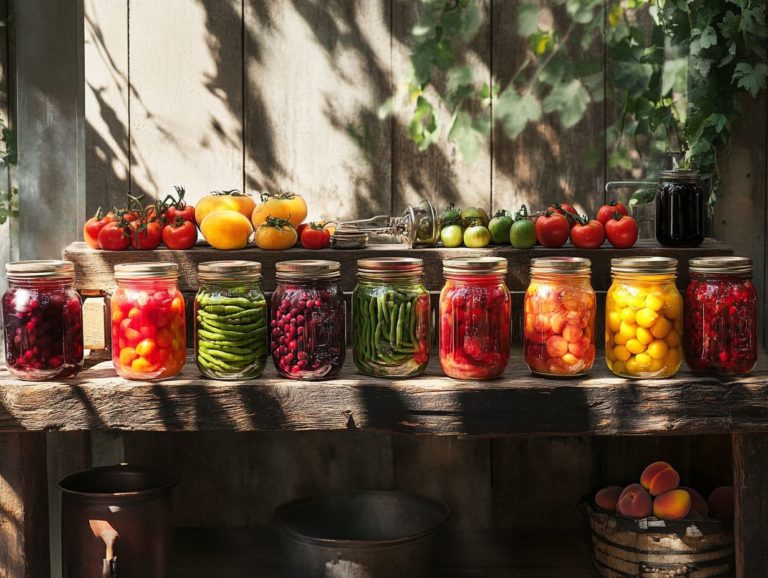Tips for Reusing Canning Lids Safely
Canning is a cherished tradition for preserving seasonal produce. But have you ever considered what happens to those lids once you re finished? Many individuals ponder whether these lids can be reused, and the answer isn’t as straightforward as it may appear.
This exploration delves into the nature of canning lids, their advantages, and the environmental implications of reusing them. You ll discover essential safety tips for cleaning and sterilizing, potential risks to be aware of, and practical advice for successful reuse.
Embark on this journey with us as we navigate the intricate details of canning lid reuse. Get ready to transform your canning experience and make a positive impact on the environment!
Contents
- Key Takeaways:
- Benefits of Reusing Canning Lids
- How to Safely Reuse Canning Lids
- Potential Risks of Reusing Canning Lids
- Tips for Successful Reuse of Canning Lids
- Frequently Asked Questions
- Why is it important to properly reuse canning lids?
- How many times can canning lids be safely reused?
- What can I do with used canning lids?
- What is the proper way to clean and sterilize canning lids for reuse?
- Can I reuse canning lids if they are dented or damaged?
- Are there any exceptions to reusing canning lids?
Key Takeaways:
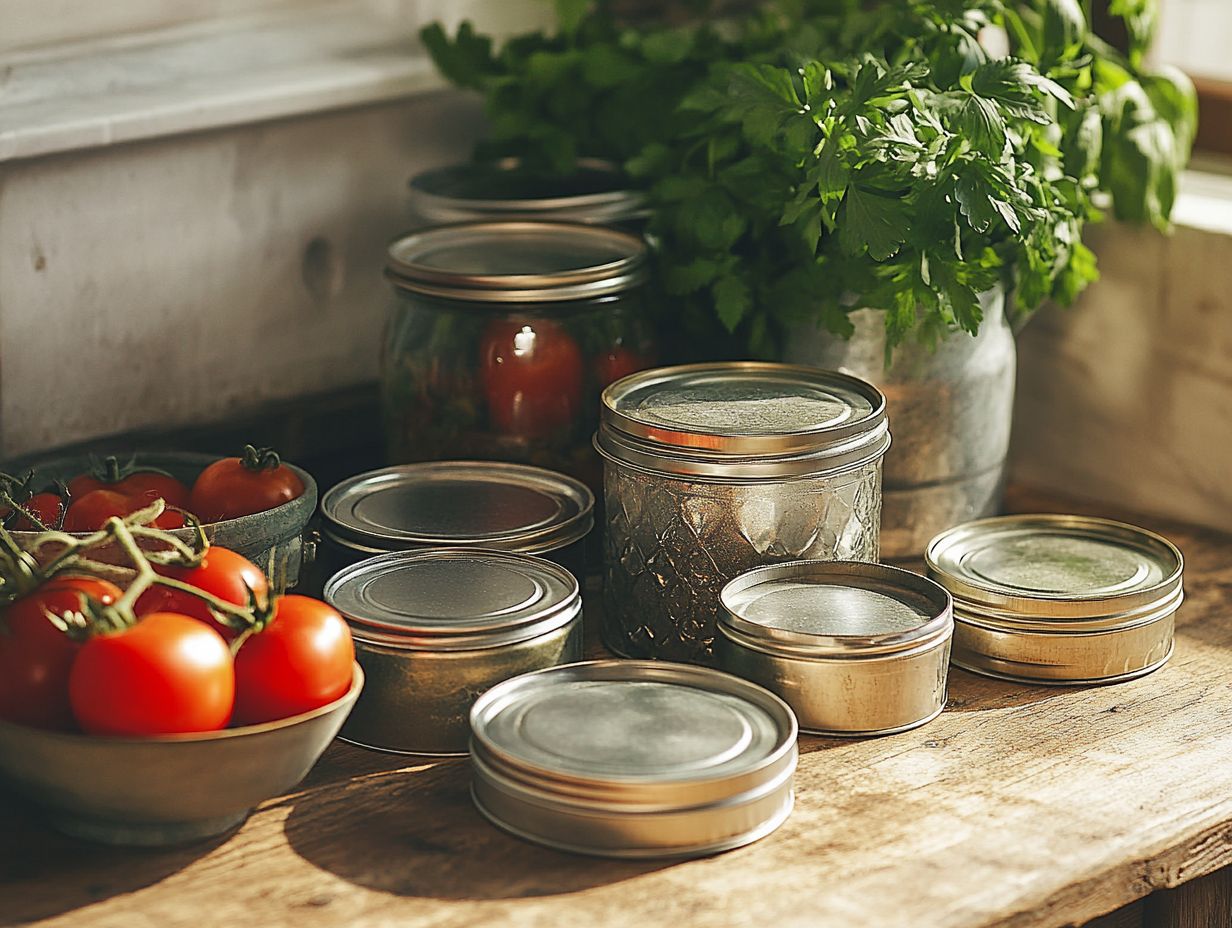
- Save money and reduce environmental impact by safely reusing canning lids.
- Proper cleaning and sterilization techniques are essential for safe reuse of canning lids.
- Reduce the risk of food spoilage and contamination by following storage and labeling recommendations for reused canning lids.
What are Canning Lids?
Canning lids are essential for food preservation. They create seals that keep air out on jars during canning, ensuring the safety and longevity of your stored food.
Made from safe and durable materials, these lids come in various brands, such as Tattler, Ball, and Kerr, catering to everyone from novice to expert canning enthusiasts.
Understanding the different types of canning lids, including reusable options, is crucial for successful home canning. This is especially important when you re working with homegrown produce, like those ripe tomatoes from your garden.
There are essentially two types of canning lids: single-use metal lids with a sealing compound, and reusable lids made from silicone or plastic. The metal lids, often coated with tin or aluminum, are the go-to choice among home canners. They guarantee a robust seal when heated in a canner. In contrast, reusable options like those from Tattler promote more sustainable practices.
Selecting the appropriate lid is vital. Improper sealing can lead to food spoilage or contamination, which poses significant safety risks. Using expired lids or mismatched lids with jars can compromise the integrity of your seal. Therefore, it s essential to understand the functionality of each lid type and adhere to proper sealing methods for safe and effective canning.
Benefits of Reusing Canning Lids
Reusing canning lids not only offers substantial cost savings for canning enthusiasts but also fosters a more sustainable and environmentally friendly method of food preservation. By choosing to reuse lids, you actively reduce waste and minimize the demand for new materials. This aligns your kitchen practices with eco-conscious principles that are vital for sustainable food preservation.
Knowing the proper guidelines for reusing lids keeps food safety at the forefront of your efforts. This effectively mitigates the risks of spoilage and contamination.
Cost Savings and Environmental Impact
The cost savings from reusing canning lids can be quite impressive, especially for those who regularly preserve large quantities of garden produce. By opting for reusable lids instead of buying new ones each season, you can redirect your budget toward other canning essentials, such as high-quality jars and must-have equipment.
This approach not only minimizes waste but also fosters a more sustainable kitchen organization. It aligns perfectly with modern efforts to reduce environmental footprints and ensures efficient use of supplies.
Statistics suggest that you could save around $20 to $50 annually by reusing lids, depending on how often you engage in home canning. While that might seem modest, over the years, those savings can really add up.
The negative environmental impact of single-use products in the canning industry is significant. Each canning season generates thousands of tons of waste. By embracing a mindset centered on ecological consciousness in your canning practices, you not only reap financial benefits but also contribute to a broader movement toward sustainable food preservation, helping to create a healthier planet for future generations.
Start saving money and the planet today by reusing your canning lids!
How to Safely Reuse Canning Lids

You want your canned goods to be safe! Follow these crucial steps to ensure your family’s health. Safely reusing canning lids requires careful cleaning and sterilization. For more information, refer to these tips for safe canning practices, which ensure that food safety remains uncompromised throughout the preservation process.
It s crucial to adhere to established guidelines from trusted sources, such as the USDA or the National Center for Home Food Preservation, to prevent the risks of spoilage and contamination in your preserved foods.
By using proper cleaning methods for reusable lids, you can confidently enjoy your homemade preserves, knowing that you re taking all the necessary precautions, especially when using fresh produce from your garden.
Proper Cleaning and Sterilization Techniques
Proper cleaning and sterilization techniques for canning lids are essential for maintaining food safety throughout the canning process. Each lid must be free from contaminants before sealing your jars of produce.
In addition to boiling, you can use a steam canner or hot water bath. These methods provide effective sterilization and are easy to use.
It s vital to dry the lids thoroughly before use. Any lingering moisture can compromise the seal, leading to spoilage, especially with high-acid foods like tomato sauce. Always inspect lids for signs of damage, such as bent edges or wear that could affect sealing.
This attention to detail enhances overall food safety and sets the stage for a successful canning experience, ensuring the longevity and quality of your preserved goods while maintaining a well-organized kitchen.
Potential Risks of Reusing Canning Lids
Reusing canning lids may seem like an eco-friendly choice, but it s essential to recognize the potential risks involved, particularly the challenges of ensuring an airtight seal during canning. Among these concerns are the threats of food spoilage and contamination.
Lids can experience wear and tear over time, which may compromise their ability to form an airtight seal. This lapse can allow air and bacteria to seep into the jars, jeopardizing the safety of your preserved food, particularly concerning when using produce from your garden.
Being aware of these risks is crucial for anyone who enjoys canning. It underscores the importance of proper handling, storage, and regular monitoring of your canned goods.
Food Spoilage and Contamination
Food spoilage and contamination are significant risks when canning improperly, especially if you reuse canning lids that might not seal effectively. A lid that fails to create an airtight seal can expose your food to harmful bacteria, leading to health risks.
Know these dangers to protect your food, especially when it comes to safe practices like proper seal checks and equipment maintenance throughout the canning process.
Beyond faulty sealing, inadequate cleaning of utensils and jars can also compromise food quality. Residue from previous batches can harbor bacteria and mold, accelerating spoilage.
It s crucial to adhere to guidelines set forth by reputable organizations like the USDA and the National Center for Home Food Preservation. They provide critical recommendations for canning practices. Following these guidelines helps keep your food safe and fresh, ensuring a healthier experience for everyone involved in your kitchen organization efforts.
Tips for Successful Reuse of Canning Lids
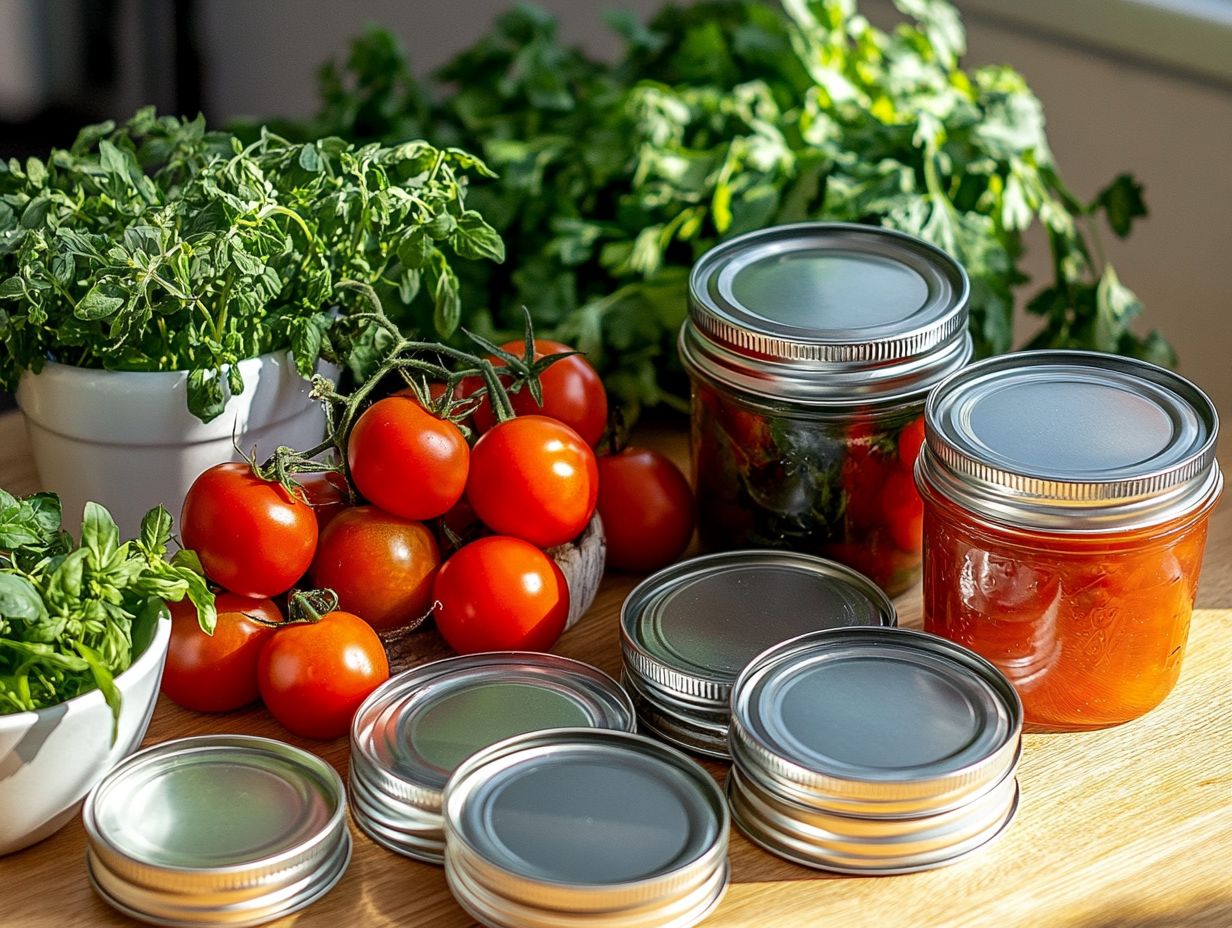
For a successful reuse of canning lids, it’s essential to use good storage and labeling practices. These methods maintain order and elevate your overall canning experience, helping you manage your supplies effectively.
By storing lids in a cool, dry place, you can significantly extend their lifespan. Properly labeling your jars helps you keep track of contents, storage times, and processing dates. This is crucial for effective inventory management in your kitchen.
With these strategies in place, you can confidently preserve your harvests and ensure that neither safety nor quality is compromised during the canning process.
Storage and Labeling Recommendations
Storage and labeling recommendations are essential for ensuring the longevity and safety of your preserved foods. This is especially important when using reusable canning lids.
By adopting proper storage solutions like keeping your jars in dark, cool places you can effectively prevent spoilage and maintain the quality of your canned goods.
Clear labeling of contents and processing dates simplifies identification and enhances your inventory management. Prioritizing these practices allows you to relish your preserved produce without worrying about food safety issues.
Maintaining an optimal temperature range between 50 F and 70 F is vital. Extreme heat can compromise the quality of your preserves. Minimize exposure to direct sunlight as UV rays can lead to color fading and nutrient loss.
To keep everything organized, consider a systematic labeling approach. Detail not just the type of food but also the processing method used, such as whether you used a boiling water bath or pressure canning. Track the freshness of each jar easily! It s a simple step that makes a big difference!
An organized pantry doesn t just streamline meal preparation; it enhances your overall enjoyment of those delightful homemade preserves.
Frequently Asked Questions
Why is it important to properly reuse canning lids?
Properly reusing canning lids ensures food safety and prevents spoilage. It also saves money and reduces waste.
How many times can canning lids be safely reused?
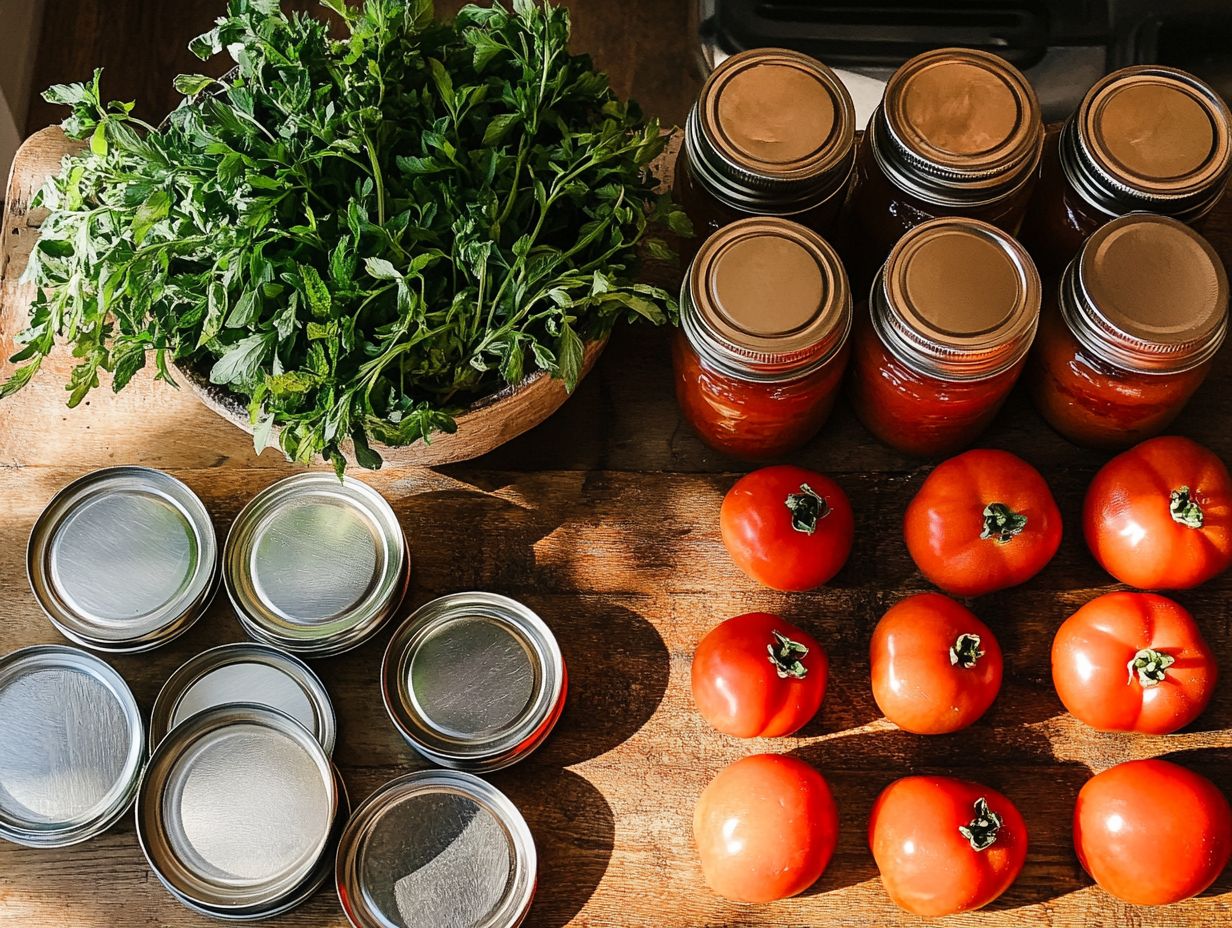
Canning lids are designed for one-time use only. Reusing them more than once can compromise the seal and increase the risk of spoilage and foodborne illness.
What can I do with used canning lids?
Used canning lids can be repurposed for craft projects or recycled. They may also help organize your kitchen. Additionally, they can be used for non-canning food storage, such as keeping leftovers in the fridge.
What is the proper way to clean and sterilize canning lids for reuse?
Canning lids should be washed with hot, soapy water. Then, sanitize them in boiling water for 10 minutes before use. This kills any bacteria that may be present and is essential for ensuring food safety.
Can I reuse canning lids if they are dented or damaged?
No, canning lids should not be reused if they are dented, rusty, or damaged in any way. These can compromise the seal and lead to food spoilage. It s important to inspect your equipment regularly.
Are there any exceptions to reusing canning lids?
Some manufacturers, such as Tattler, make reusable lids specifically designed for multiple uses. However, it is still important to follow the manufacturer’s instructions for proper cleaning and storage.


